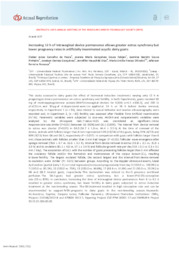Increasing 12 h of intravaginal device permanence allows greater estrus synchrony but lower pregnancy rates in artificially inseminated acyclic dairy goats.
Increasing 12 h of intravaginal device permanence allows greater estrus synchrony but lower pregnancy rates in artificially inseminated acyclic dairy goats.
Author(s): PAULA, C. J. C. de; SOUZA-FABJAN, J. M. G.; PINHEIRO, J. B. S.; GONÇALVES, J. D.; DIAS, J. H.; OLIVEIRA, M. E. F.; FONSECA, J. F. da
Summary: This study assessed in dairy goats the effect of hormonal induction treatments varying only 12 h in progestogen device permanence on estrus synchrony and fertility. In both Experiments, goats received 60 mg of medroxyprogesterone acetate (MAP) intravaginal devices for 6 (G6) or 6.5 d (G6.5), and 200 IU of eCG i.m. and 30 ?g of d?cloprostenol were i.m. applied at 24 h or 36 h before device removal, respectively. In Experiment 1 (n = 24), data related to sexual behavior and ovarian ultrasonography were recorded and, in Experiment 2, (n = 83) fertility was assessed after Flexible Time Artificial Insemination (FxTAI). In conclusion, increasing the time of intravaginal device permanence from 6 to 6.5 d resulted in greater estrus synchrony, but lower fertility in dairy goats subjected to estrus induction treatment at the non?breeding season. The G6 treatment resulted in high conception rate and can be recommended to support FxTAI programs in dairy goats in the non?breeding season.
Publication year: 2020
Types of publication: Abstract in annals or event proceedings
Unit: Embrapa Goats & Sheep
Observation
Some of Embrapa's publications are published as ePub files. To read them, use or download one of the following free software options to your computer or mobile device. Android: Google Play Books; IOS: iBooks; Windows and Linux: Calibre.
Access other publications
Access the Agricultural Research Database (BDPA) to consult Embrapa's full library collection and records.
Visit Embrapa Bookstore to purchase books and other publications sold by Embrapa.

